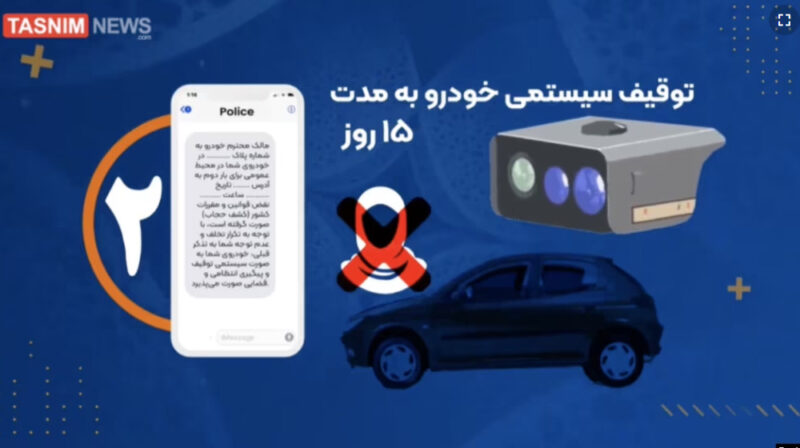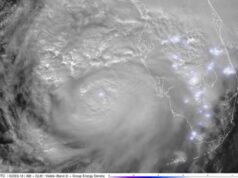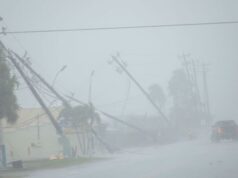Iran’s new domestic surveillance program for enforcing its mandatory hijab law is having a shaky start, with many women appearing to ignore it, lawyers sharply criticizing it and activists observed to be plotting to subvert it.
Iranian state media said the program went into effect April 15. A week earlier, Iran’s national police chief, Ahmad Reza Radan, said it would employ advanced surveillance capabilities, including street cameras, to identify women violating the law requiring them to wear a hijab to cover their hair in public in accordance with an Islamist dress code reviled by secular Iranians.
A video posted Monday on the state-run Tasnim news site used animation to show how part of the program works. It said women caught on camera not wearing a hijab inside vehicles would receive text message warnings from police and could see their vehicles impounded if they ignore those warnings.

It was not immediately clear how many new cameras were installed for the surveillance program and where. Iran had been using street cameras to record traffic violations.
Many women in Iran appear undaunted by the increased surveillance. Over the past week, VOA Persian has observed a series of what it deems to be credible social media videos showing women in different parts of the country walking unveiled in public in defiance of the hijab law.
In one video received by VOA Persian TV host Masih Alinejad and posted to her Telegram channel on Friday, an unveiled woman can be seen walking along a street at night and raising her arms in defiant gestures as she and other women around her chant “Radan, get lost,” a reference to the Iranian police chief, and “death to the dictator,” a reference to Supreme Leader Ayatollah Ali Khamenei.
Alinejad said the sender of the video told her it was filmed in the Jolfa neighborhood of the central city of Isfahan. VOA cannot independently verify the locations and dates of the observed social media videos because it is barred from reporting inside Iran.
Iran’s Kayhan newspaper, which is run by a Khamenei aide, dismissed the videos of unveiled women broadcast by Western-based Persian news channels. In an April 16 commentary, it called those videos fake without citing evidence.
Several prominent lawyers in Iran criticized the new hijab surveillance program as ill-advised and illegitimate in comments to state-approved news sites.
Tehran-based lawyer Ali Mojtahedzadeh told the Didban Iran (Iran Watch) site in an April 15 article that he believes the program will violate people’s privacy.
“Photography is [acceptable] for traffic violations, but it is a strange and expensive technique for identifying people without a veil. I consider this to be against the law and against reason and logic,” Mojtahedzadeh said.
In a commentary published April 17 by the Khabar Online site, Iranian law professor Nemat Ahmadi expressed doubt that the surveillance cameras will produce the desired result.
Ahmadi said Iran should learn from nationwide antigovernment protests that erupted in September and not lay the groundwork for more actions that would inflame the public and try to distract people’s attention from economic problems.
This week’s VOA Flashpoint Iran podcast examined the technology behind Iran’s surveillance program in an interview with Yasmin Green, CEO of Google subsidiary Jigsaw, which develops technology to address threats to open societies.
The following transcript of Green’s April 17 interview has been edited for brevity and clarity.
VOA: Is the initial defiance of the camera surveillance by Iranian women a sign that this system will not work, or is it too early to say?
Yasmin Green, Jigsaw CEO: So Iran’s use of cameras and CCTV to spy on people in public spaces, read license plates and identify people who are driving cars and not wearing hijabs has been in place for a while. What has recently been announced is almost a scaling up of the enforcement, as opposed to any new technology, as far as I can tell.
It is documented that the Iranians have purchased technology from China to be able to do facial recognition. It is not clear that they are using that technology in this deployment that just started. But I anticipate that we will see more sophisticated facial recognition systems deployed, because the investments have been made.
VOA: We have heard that Iranian authorities may impose financial penalties on women photographed without a hijab and summon them to court. But there is no clear explanation of the penalties. How do you think Iranian women are going to respond?
Green: My expectation is that if people do not respond to warnings, and those warnings are not an effective deterrent, then the penalties will become more severe, whether they are financial penalties or prison and other types of physical violence that the Iranian government is capable of.
Clearly, there is a recognition by the government that during the last six months of protests, the bloodiness of it has not advanced their reputation. So they are looking to move from the more brutal public morality police to a more private and scalable morality tech enforcement. They have done a lot of public relations inside the country, with the police chief speaking about the deployment and how it is going to be very accurate. They are hoping that will work.
They also are talking to businesses and attempting to rally their supporters in the country to inform on people who are not observing the hijab law, as a way to complement the technology angle.
VOA: What kind of high-tech tools can Iranian women use to protect themselves from this kind of surveillance and fight back against it?
Green: There are conversations happening inside the country about how the system could be subverted. Because technology systems are vulnerable to getting things wrong — in particular, by making assertions that something is happening when it is not — the language used in the field to describe this vulnerability is false positives.
One subversive idea considers if this system could be flooded with false positives, making it think that it has seen women without a hijab when that has not been the case. So, you could maybe break the system if, for example, a lot of men wearing wigs or men with long hair went out [to be spotted by the cameras].
Also, because authorities are asking individuals on the ground to inform them [about unveiled women], anybody could use that reporting mechanism and inform on somebody who was wearing a hijab. So these systems are vulnerable.
Once facial recognition systems are in place, they become scarier and harder to circumvent, because you actually have an audit trail for the image of a person whom you could interrogate.

















